The Best New York Style Pizza Dough and 14 Tips for Success!!
I’ve been making a lot of this NY style pizza dough recipe …. The obsession started a while back, and I’ve finally found a recipe that I love the best! After years of experiments (and I mean years!), I am now using this recipe based on recommendations from the many fine pizza makers at www.pizzamaking.com and the late great Dough Doctor, Tom Lehmann.

Making Pizza Dough at Home
Making NY style pizza dough is definitely somewhat of an art form. There are so many variables that can be changed aside from the ingredients alone. For example, these variables include:
- oven temperature
- temperature of the water used to make the dough
- proofing methods (room temp vs cold rise)
- order of adding the ingredients (yes, this makes a big difference!)
- mixing time
- use of autolyse
- use of poolish (I don’t do this or the one before, although I have in the past)
And then of course, the toppings which can be simple or as complex as you’d like. But don’t worry too much about all of this – my method is easy and straightforward. Plus, you will make better dough than 99% of the pizza chains out there. You will not want take out anymore!
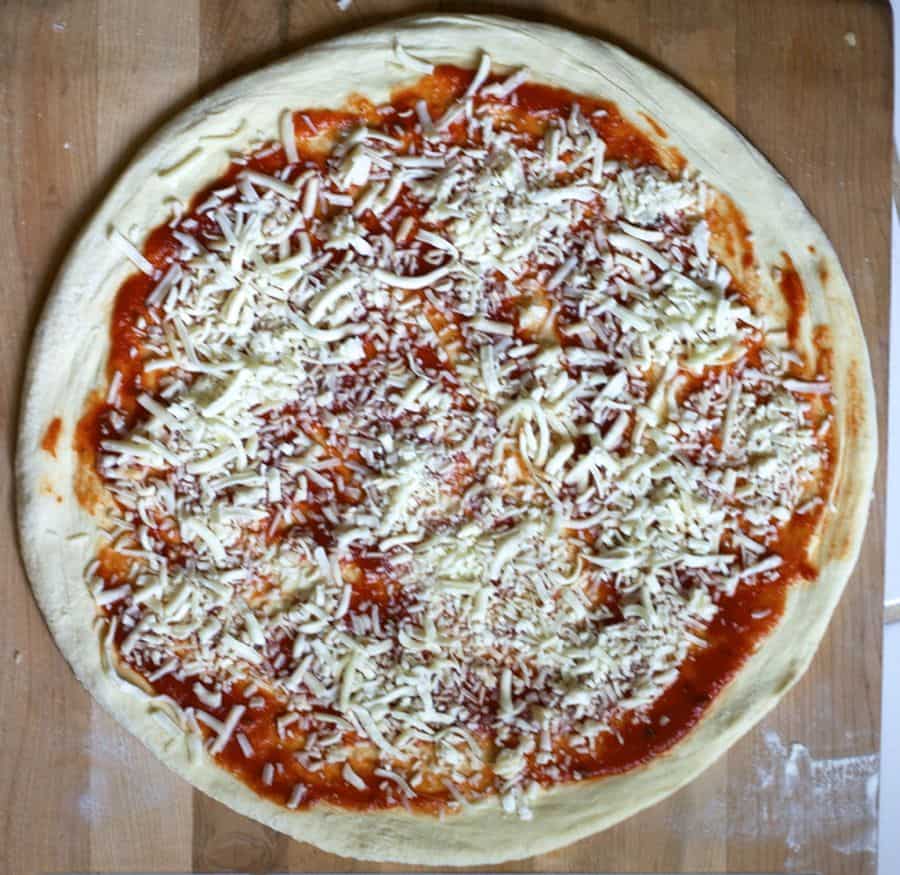
My Favorite Pizza Dough: The Big Secret (How You Proof the Dough)
My all-time favorite dough is NY style dough, which really is classic pizza dough that is stretched out into a thin crust pizza. This type of pizza dough contains water, flour, salt, instant yeast, and olive oil (and sugar especially when baking in a home oven, to help browning).
After it is mixed, it is proofed (left to rise/ferment) in the refrigerator for a minimum of 24 hours and up to 72 hours (it can also be frozen) – this is the big secret. I’ve used the dough up to 5 or 6 days afterwards, so you can essentially prepare dough for the week.
This recipe produces a crisp yet foldable crust that is tender, light, and flavorful and will make enough for four 14-inch pizzas. You can easily double or half the recipe to make 2 or 8 pizzas.

Fourteen Tips for Success
Tip 1: Choosing the flour
Use high-quality flour – I like to use King Arthur’s all purpose or bread flour; higher protein (ie, bread) flours work best. However, I prefer all-purpose flour because I like a lighter, airy crust.
Tip 2: Adding the yeast
Do not add instant dry yeast (IDY) directly to cold or cool water – you may shock the yeast (add the IDY to your flour instead) (please note that IDY differs from active dry yeast, which must be activated by adding it to water).
Tip 3: How much yeast?
Use only enough yeast to “get the job done” – yeast eats the sugar in your flour to produce its leavening effects – I find that if you use too much, your dough will be tasteless (this is just my opinion); however, it is a fact, that too much yeast can make your dough taste bad. Most recipes out there, some of them in well known, published books contain too much yeast!
Tip 4: Cold ferment that pizza dough!
Always use your refrigerator. The best NY style doughs “ferment” or “cure” in the refrigerator for at least 24 hours and up to 48 72 hours. This is called a “cold rise” (vs warm rise on your kitchen counter).
The refrigerator is used to retard (or slow) the dough’s fermentation, allowing that distinctive flavor to come through (ever wonder why some pizza crust tastes different than others, despite the fact that they are both made from just about the same exact ingredients? – this is a big reason why!)
When your dough rises too quickly, the flavor will not develop optimally. Slow rise = MUCH better flavor.
Tip 5: Weigh those ingredients!
Use a scale to weigh the flour instead of using a measuring cup – it is much more accurate and will yield superior results. I’ll admit, I resisted doing this for a loooong time. Just do it. You’ll be glad you did and your dough will be more consistent and much improved.
Tip 6: Add oil last
Mix the oil in as the last step, after the flour has all been incorporated. This is important to allow the flour to hydrate properly.
Tip 7: Flour your dough balls
Before tossing or opening your dough balls, flour them *very* well on each side (if you are a beginner) to ensure they do not stick to your counter or pizza peel. I sometimes use a bit more flour after I begin spreading them.
Tip 8: Keeping those rims a bit puffy
Take care not to “degas” the rim of your pizza as you are spreading your dough! Do NOT ever use a rolling pin! There are many different methods to spread/open your dough ball. I hope to add a few pictures someday of this process.
Tip 9: Baking pizza in a home oven
Ensure that your oven is preheated for a sufficient amount of time (about 1 hour) and bake the pizza within 6 to 8 inches of the top of your oven (ie, your broiler) so that the tops browns sufficiently in conjunction with the bottom of the pizza.
Do not place the stone near the bottom of your oven. I made this mistake for too many years.
After your stone has been preheated sufficiently, the heat from the stone will cook the pizza from the bottom and you can switch the broiler on if you find you need more browning on the top (I now use the broiler to bake my pizzas…more on this sometime in the future).
If you find that your cheese is browning well before your rim attains sufficient color, use partially frozen cheese (ie, place shredded cheese in the freezer while the oven is heating up) and cold sauce or you can drizzle just a bit of olive oil on top of cheese.
Tip 10: Use a pizza stone or steel
Use a pizza stone if you have one. The stone with draw moisture out of the dough and produce a beautifully crisp crust. I use a pizza steel because my stones kept breaking.
Tip 11: Use just the right amount of sauce
Do not use too much pizza sauce – it will make your pizza soggy
Tip 12: Find the right kind of cheese
Do not use low fat cheese to top your pizza or pre-shredded cheese (the former will not melt sufficiently and the latter contains additives that prevent the cheese from sticking together and therefore does not melt very well). The best is low-moisture, whole milk mozzarella.
If you must use pre-shredded cheese, I’ve found that adding the sauce on top of the cheese helps with the melting. Also, do not use too much cheese; apply it sparingly so that you can achieve that mottled NY pizza appearance.
Tip 13: Flour your pizza peel
Use semolina or flour on the bottom of your pizza peel to prevent the pizza dough from sticking but be careful not to overdo it because it will burn.
Tip 14: Learn to launch that pizza
Give the pizza peel a few very small quick jerks to make sure the pizza will easily slide off your pizza peel before attempting to transfer pizza to the oven, and more importantly, rub flour into the peel before placing the dough on top.
Essential Equipment
Please note that as an Amazon affiliate, we earn a small commission if you purchase a product at no additional cost to you.
I adore my baking steel; it’s transformed my home pizzas into restaurant-quality and better. You will love this! A kitchen scale streamlines measurement with remarkable accuracy, while a pizza peel is essential for smoothly sliding pizzas into the oven. And proofing boxes provide an optimal storage for pizza dough fermentation, enhancing flavor, texture, and elasticity.
Please visit our SHOP page for more recommended tools and equipment to make restaurant-style NY-style pizza at home!
How to Stretch the Pizza Dough
A nice video (from The GoodFellas Pizza School of NY), showing how to stretch the dough:

How to Freeze Homemade Pizza Dough
- After mixing dough and dividing into balls, place dough in refrigerator for at least 24 hours.
- Place dough balls on baking sheet lined with plastic wrap or parchment paper, cover loosely with plastic wrap and freeze until firm (~ 2 to 3 hours or up to overnight).
- Wrap frozen dough balls individually in plastic and store in zipper-lock bags for up to 4 weeks.
- When ready to bake, transfer unwrapped dough into the refrigerator for 12 to 24 hours before making pizza.
- Bring dough to room temperature for 20 to 60 minutes before baking (less time for hot kitchen/summer and more time for cool kitchen)
Pizza Dough Calculator
Need more dough? Less dough? Try out our new Pizza Dough Calculator to calculate the weights to get it just right!
Have More Questions?
Please See My NY Pizza FAQ
If you tried this recipe, please leave a 🌟 star rating and let me know how it went in the 📝 comments below! SUBSCRIBE for more recipes.
📖 Recipe

The Best New York Style Pizza Dough
Equipment
- pizza stone or pizza steel for baking
- Standing mixer optional or hand knead
- kitchen scale highly recommended instead of volume measures
Ingredients
Original Recipe for Four 14-Inch Pizzas; want to make more or less? Use the pizza dough calculator
- 6.5 cups (796 g) all purpose flour or bread flour (weighing is most accurate!)
- 2 1/4 cups (493 g) water barely cold water (17.4 oz per 2 1/4 cups)
- 1 teaspoon (3.5 g) instant dry yeast
- 2.5 teaspoons (15.6 g) salt
- 2 teaspoons (7.8 g) sugar
- 1 tablespoon (11.8 g) olive oil
1 Pound of Dough (~454 grams) (use the pizza dough calculator to make more or less dough)
- 2 1/4 cups (274.5 g) all purpose flour or bread flour
- 3/4 cup (170.2 g) water
- 1/2 teaspoon instant dry yeast
- 1 teaspoon salt
- 3/4 teaspoon sugar
- 1 teaspoon olive oil
Instructions
Mixing the Dough
- Place water in mixing bowl.
- In a separate bowl, mix salt and yeast (and sugar if using) into flour
- Combine flour/salt/yeast mixture into water and mix until all the flour has been incorporated.
- After flour has been totally incorporated, add oil and knead for about 4 to 5 minutes (see note)
- Test final dough temperature, which should ideally be between high 70s to low 80s (optional)
Dividing and Rising
- Divide dough into 4 equal pieces (using a digital scale if possible; each ball should weigh 11.5 oz [~326 grams]), shape into a ball, and place in greased, sealed quart-sized container or oiled/greased freezer bag and refrigerate overnight or up to 72 hours (After much experimenting, I have concluded that I like 3 days best but day 2 is good too).
Assembly and Baking
- The following day, remove your dough balls within 1 hour or less of baking and allow the dough to come to room temperature. (the dough will tend to blister more if the dough has not been allowed to come to room temperature however, I often bake coldish dough without problems, just some bubbling)
- In the meantime, place your pizza stone in oven and preheat at 550 degrees (depending on thickness of your stone and your oven’s power) for at least 1 hour
- Open each dough ball using care not to degas, transfer to a pre-floured pizza peel (or on parchment paper), and top with your favorite sauce, cheese, or other toppings.
- Transfer pizza from peel to oven or slide parchment paper onto preheated pizza pan/stone and bake for 4 to 6 minutes each until browned on top and cheese has melted but not burned.
- Enjoy!
Notes
- Use of weight based measurements is highly recommended instead of US Customary. You will need a kitchen scale.
- METRIC amounts DO NOT correspond exactly to the US Customary amounts because, for example, 796 grams equals 6.4 cups (and most can’t measure 0.4 cups or 0.22 cups). Recipe was based on grams.
- Use the Pizza Dough Calculator
- If you want to use the dough the next day, knead a little more (slow speed for about 8 to 10 minutes)
- If you have time to let the dough rest for 3 days, knead for 4 to 5 minutes, low speed or hand knead.
- After mixing dough and dividing into balls, place dough in refrigerator for at least 24 hours.
- Then, place on baking sheet lined with plastic wrap or parchment paper, cover loosely with plastic wrap and freeze until firm (~ 2 to 3 hours or up to overnight).
- Wrap frozen dough balls individually in plastic and store in zipper-lock bags to store for up to 4 weeks (longer may work, but results might vary).
- Before using, transfer unwrapped dough into the refrigerator for 12 to 24 hours before making pizza.
- Bring dough to room temperature for 20 to 60 minutes before baking (less time for hot kitchen/summer and more time for cool kitchen).
- calculate your own using baker’s percentages: 62% hydration, 0.4% yeast, 2% salt, 1.5% oil, and 1% sugar or use my new pizza dough calculator.
Nutrition
Try these other pizzas and this NY pizza sauce:
Buffalo style (one of my absolute favorites)
White with prosciutto
White with spinach and feta
Pizza sauce

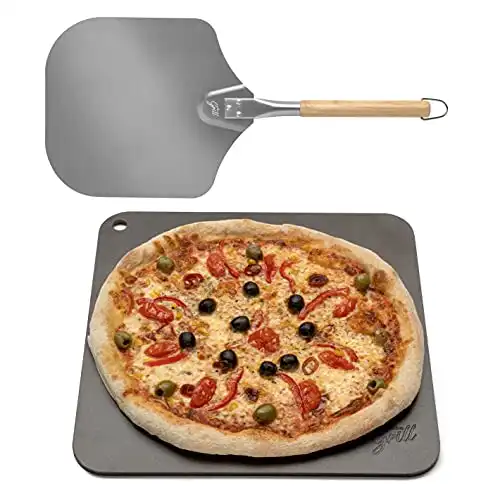
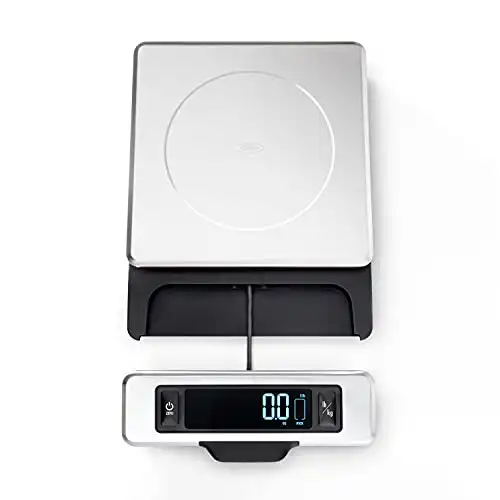
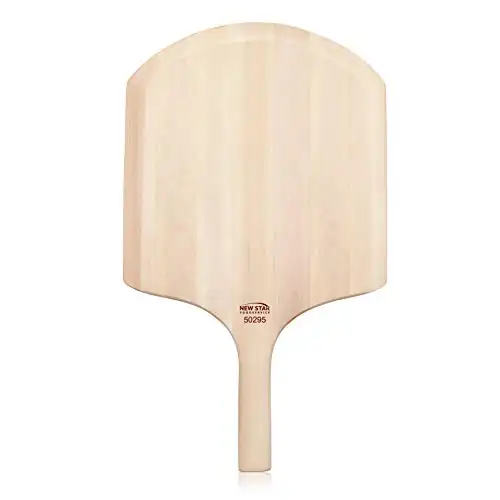
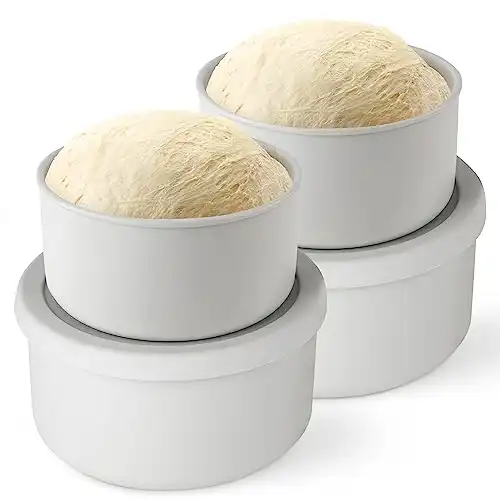
Marie,
Let me edit my last post, I had it reversed. For NY style, I notice you recommend dividing the dough and forming dough balls prior to refrigeration. Other suggest to divide the dough but not shape into balls until after removing dough from refrigerator, then letting it come to room temp. Do you believe it makes a difference?
Hi CJ- It probably does. Honestly, I haven’t experimented enough to comment. I’d say try both ways and see what you like better. Reballing will strenghten the dough and so it’s a question of doing this earlier vs later. I’ll have to try this out next time I make dough
Marie,
For NY style, I noticed you recommend dividing the dough but not forming the dough ball until after the refrigeration period. Others suggest to cut and form the ball prior to refrigeration. I will take your advice, but in the meantime do you believe it makes a difference.
Thank you for the recipe. When making the dough, I used active dry yeast in the flour and then mixed that into about 105 deg water and proceeded to mix it after that for everything to come together. I was wondering if anyone else had ever done this or what the possible effects might be. I still put the dough into the fridge and will leave it there for about 2 days. Thanks.
Hi Josh – that should work fine. I can’t recall what brand it is, but one of them states on their website that you can use active dry interchangeably with instant, also called rapid rise. Check the yeast manufacturer website for “frequently asked questions”. Hope it came out good!
Hope I didn’t miss this answer somewhere else: Do you let the dough rise for 3 days before freezing it or do you freeze it directly after mixing? I find that we can make 4 pizzas with this recipe, so the option to freeze 2 of the dough balls is perfect. I am experimenting with bread flour vs. all purpose. Thank you for a great recipe; my family loves Friday Pizza Night!
Glad you like it! You can freeze after a day of refrigeration.
I have always thought I didn’t have the right flour or recipe. Never could get that nice chewy crust. Thanks to you I just did. I didn’t use a rolling pin and stretched it like the video and violas!
Thank you. Thank you. Thank you. Or I should say, grazie mille!
Wooo hoo! Happy you like it:)
Thanks so much for the recipe I know it is an older post but I have been hunting for a great Pizza base recipe. I am in Australia but my husband is from America and he misses great pizza (it is not great here) but he loved this pizza base. Thank you.
Great! Happy it worked for you!
Wow! What an incredible recipe! I have been making pizza dough for several years now and this is by far my favorite. Seeing as I am a starving college student, I will not be able to make it out to NY for legitimate pizza anytime soon. This recipe is like traveling to the east coast! I made this for my entire family and my boyfriend said it was the best pizza he has ever had (a great compliment from a true foodie). I live on an organic farm, so I love to get creative with my ingredients and make yummy veggie pizzas. Thank you so much for the tips and the recipe! We will never eat out for pizza again. 🙂
Marie–I’m hoping you can help. I’ve made this recipe and I think I’m on the right track now, but I’m definitely missing something in my technique. I hand-kneaded the dough , refrigerated for the recommended time, then put my four separate doughs in the freezer. I’m thawing them for a about a day then taking them out about an hour or so before baking. They seem a bit moist to me at this point. I dust them with more flour, form into a ball (since they’ve become thin and flat in the fridge during the initial 3 day rise. (is this the problem??) The issue I’m having is that the dough isn’t shaping nicely into a disk, but :”fighting” me as I try to shape it, and when I pick it up and try to form it with my fists, the outside stays thick while the middle is thin to the point of breaking. The flavor isn’t bad, but it still seems a bit underbaked to me, though the outside looks okay. I’m using the top oven rack at 550, but the bottom of the crust isn’t getting the doneness I’d like, which may be why the pie tastes underbaked, even the though the top is done and the edges are somewhat crunchy. Would appreciate any thoughts. Thanks
If the dough is tearing and “fighting you”, the gluten probably didn’t develop enough. You either need a higher protein flour (bread flour) OR you can try to knead the dough longer next time. You can also try to incorporate some reballing of the dough (just fold dough the edges to form a ball again out of the flattened dough after it has been in the fridge for a day). You can use the pizza dough the same night as you take it out of the freezer. you can use as much flour as you need to reduce the stickiness – just don’t re-knead the dough. dust the top and bottom and then stretch it out. Hope this helps!
Thanks for the help!
Hi Marie
I made you pizza dough recipe yesterday and am planning to make the pizzas tonight. Is there a reason why the oven needs to be preheated for an hour prior to baking the pizza? I am so looking forward to having pizza this evening.
Thanks for your advise. Cathy
Hi Cathy – the longer preheat is mostly to ensure that your pizza stone has heated up sufficiently.
Hi! I’ve new to the homemade pizza game. I’ve made probably 20 homemade pizzas using a bread machine to make the dough. I’m looking for more flavor and am going to give this recipe a shot. The recipe I had been using called for 2.5 cups of flour, so I would use a volume versus weight calculator (http://www.traditionaloven.com/conversions_of_measures/flour_volume_weight.html) to use exactly 2.5 cups based on the type of flour I was using (bread/AP/WW). So the weight of the flour used in the recipe would vary, but not the volume. Looking at your recipe, it seems that the constant should be weight, and not volume? Is that right? Thanks for your help!
Hi Robert – yes, you are correct – this recipe is best made by weight but you can use volume if you don’t have a scale.
Hi Marie,
I just found your website and tried to do the dough steps last night. However, it seems like it is almost impossible to find instant yeast in this area. I’ve gone to 4 different stores and all I can find is quick rise or active yeast. I used active last night, but I think I maded a booboo. I used double the amount you were supposed to and I poofed it in warm water and the sugarr (there were no isntructions int he package). I then added that liquid into the cool water in the mixer and followed the rest of the steps. At first it seemed like it wasn’t enough water, but then it all came togeher. It’s in the fridge now, and plan to leave it there for 3 days, but I wanted to ask you, do you think using double the amount of yeast and activating it with water will ruin the end results?
Instant yeast is also called quick rise yeast. YOu can also used active dry instead. No need to proof instant or quick rise yeast, and some manufactures of active dry yeast say proofing isn’t needed. Double the yeast will definitely alter the results and you should probably use it before 3 days if possible. I think too much yeast produces a very tough and hard crust…it’s okay and it will be fine to eat, just try again.
Thank you Marie. I did make another batch of dough and it was much better. The only thing is it got stuck inside the containers because it was very sticky, However, the pizza was amazing. Next time, I will put a little olive oil in the container to avoid the dough from sticking. I also need to get the stretching down, not as easy as it looks. Put wholes in my first 2 tries and had to restart, thankfully I had a few dough balls to play with. Great recipe and def a keeper! Thank you!!!
Hi Marie! I was so excited to try this recipe so I just did, with my stand mixer at low speed, followed the directions exactly, but my dough is very tough.. Any clue why?
Hi Meg – It’s hard to say but I would guess it’s because you either used too much flour or too little water. If you measured with cups, it helps to stir the flour and then spoon it lightly into the measuring cup because the flour is compacted in the bags during shipping. I hope that helps.
Thanks so much for sharing this incredible pizza dough. I wanted to reproduce the delicious pizza I got from my local NY pizza style restaurant (Voodoo Ray) and I’m not looking any further. I only used half of the proportions and made 2 pizzas. I only let the dough in the fridge for about 10min and used it straight away. It worked perfectly, I’ll make the 2nd batch in 2 days to see if it makes a big difference. That’s definitely a keeper !
Hi! Glad you liked the recipe! I’d be interested to hear if you liked the dough better after doing the cold rise for a longer period of time. It gets better!
If i want to use fresh yeast instead how much should I use?
Hi Pia – I don’t have much experience with fresh yeast, but from what I’ve read you use 33% to 40% of the total weight of fresh yeast to instant yeast. According to my calculations, it would be about 3 teaspoons of fresh for every 1 teaspoon on instant yeast in a recipe. Here’s some more info:
http://www.kingarthurflour.com/professional/yeast.html
http://www.sfbi.com/fresh-yeast-vs-instant-yeast.html
Hi I have been making this recipe for a few weeks now and have been very pleased with the results. i just noticed however that I have been using ACTIVE dry yeast. I have NOT been blooming the yeast but just following the recipe here. Should I bloom the ADY or should I only use the IDY? Any advise would be appreciated as I am a novice dough maker. Thankyou
Hi Jim – I believe it depends on what brand you are using. Red Star does not require blooming and both theirs and King arthurs can be used interchangeably with instant yeast in a 1:1 ratio. If you are using Fleishmann’s, their website recommends active dry yeast be bloomed because the granules are larger than instant or rapid rise yeast and so they must be mixed with 1/4 cup water and 1 teaspoon of sugar (http://www.breadworld.com/FAQ.aspx)
Hope that helps!